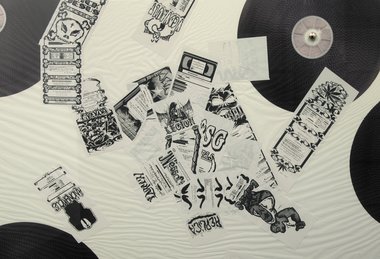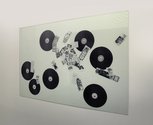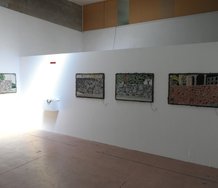Daniel Webby – 23 April, 2014
The Rosetta stone for the exhibition is a work on paper titled Saga. An inkjet print on tissue paper, the image depicts seven black discs each with a spool at the centre. The material thinness of the work is evidenced by ripples created as the print was pinned to the wall by way of a large sheet of glass. Between the glass and the large print are slips of paper, also thermally printed, which record various transactions. There is an interesting tension between the ephemerality of the lightweight paper used for the prints and the material weight of the glass.
In Nostalgia and Its Discontents, Svetlana Boym describes nostalgia as the “longing for a home that no longer exists or has never existed”, continuing, “…technology and nostalgia have become co-dependent: new technology and advanced marketing stimulate ersatz nostalgia-for the things you never thought you had lost-and anticipatory nostalgia-for the present that flees with the speed of a click.” Asserting “(t)he first decade of the twenty-first century is not characterized by the search for newness, but by the proliferation of nostalgias” Boym’s hypothesis provides a list of usual suspects; the loss of “clear borders and values”, “dislocation in space” and a “changing conception of time” which coalesce to form “a secular expression of a spiritual longing, a nostalgia for an absolute, for a home that is both physical and spiritual”.
I bring these ideas forward in considering this new body of work from Ben Clement, collectively titled Video Easy, with particular regard to Bohm’s typology of nostalgia which moves between two categories; Restorative nostalgia which “attempts a transhistorical reconstruction of the lost home” and Reflective nostalgia which “thrives on algia (the longing itself) and delays the homecoming-wistfully, ironically, desperately”. It is this latter characteristic which most directly informs Clement’s work, with obsolescence providing the techno-social framework for an enactment of losses - with attendent algias in translation.
The Rosetta stone for the exhibition is a work on paper titled Saga. An inkjet print on tissue paper, the image depicts seven black discs each with a spool at the centre. The material thinness of the work is evidenced by ripples created as the print was pinned to the wall by way of a large sheet of glass. At the centre of each spool is a chromed stud which conceals the fixings used to secure the glass. Between the glass and the large print are slips of paper, produced using a thermal printing technique familiar to many in the form of till receipts, which record various transactions. Very little detail is afforded by this printing method, giving a coarse, graphic sensibility to the work. There is an interesting tension between the ephemerality of the lightweight paper used for the prints and the material weight of the glass, which seeks, metaphorically, to add gravity to the image.
I’ll interrupt this description to note that at a certain point the visual reading of the exhibition gives way to an interpretative act by way of supporting contextual information. Whereas conceptual art relies on a certain self-evidencing of its conceptual statements, the opaque, referential surfaces of “post-conceptual” practices bring to mind Terrence Handscome’s recent essay available here.
To return to the descriptive; the depicted discs are in fact flat-bed scanned 35mm film reels, the information described on the surface of the celluloid rendered invisible and abstract. Acting as both icon and index, the discs provide a visual analogue to the original source while also marking the disappearance of its content. That the specific scanned reels comprised one of the films from the Twilight series becomes relevant when considered with the other works in the room.
The smaller slips of paper contain textual information with graphic cues to the potentially illicit nature of the transactions which are described. The words Black Jesus float above a skull and crossbones. A marijuana leaf and a roman legionnaire are crudely rendered. The images and text detailed on the slips have been casually layered under the glass in a manner which underscores the illegibility of much of the text. These are not documents in which information is being made explicit but serve as signifiers toward a wider system of circulation.
In more precise terms, the slips are printed .nfo files, a format which often accompanies bit torrents as they enter the digital file sharing environment. Limited to basic text, the creators of .nfo files go to some trouble to generate ASCII embellishments to what are essentially release notes for the media content being illegally distributed. These files also function as a signature for the uploader, a means of enhancing status and reputation in the file sharing community. While the act of dispersion could contentiously be viewed as altruistic in nature (uploading the content carries significant risk), authorial recognition is a motivating factor.
In relation to the 35mm print, the bit torrent describes an abstraction in form that provides insight into its corresponding abstraction in value. We have become accustomed to value being decoupled from a material “gold standard”, precious due to scarcity, and will likely have some intuitive (albeit incomplete) understanding of hard currency as a store of value, but here we have a glimpse of the digital reformation of value, a value which accrues by way of proliferation across the network. Increased nodes of distribution result in faster downloads - simply, the more copies that exist, the more valued the torrent.
As a gesture toward making visible the largely invisible infrastructure required for the circulation of digital currencies, Clement has brought to the space an array of three empty server racks. As objects there is a satisfying weightless mass to the structures, a lightness afforded by the perforated black powder coated steel doors and panels which enclose the cuboid volumes. Inside two of the towers, flat screen televisions play slideshows of still images taken from one of the Twilight films - presumably the same as is signified by the film reels in Saga. Images slide into view and layer themselves with a familiar, randomised, “screen saver” logic, generating a disjointed remix of the original narrative. Of all the works the slideshows are most experientially nostalgic in affect, the sense of viewing the memory of a film further heightened by the romantic sentimentality of the imagery.
The work is titled Decommissioning Youth and provides an imagistic correlate to the signified as absent content of Saga. The server towers operate as a stage from which the slideshow images perform, but that performance has been interrupted to show this restaging as cultural artefact. The loss here is not that experienced in the movement toward abstraction, as with the scanned 35mm film reels, here loss exists as experiential discontinuity. Whereas narratives across 35mm celluloid restate the linear structure of the material, digital narratives are from the outset atomised, bits of data disassembled and reassembled across a network of servers and end user nodes. As slideshow narrative continuity dissolves into a form resembling its digital material.
It should be noted that loss is but one factor in the translation of one format to another - there are also gains. And the sheer volume of media content which is readily available “on demand” is surely one such gain. With this in mind, it is not surprising to come to the third work in the room as a sort of reflection on the social manifestations of this media consumption.
The work True Detective contains internet sourced images printed as a unified surface onto aluminium in the manner of a scrap-book collage. Movie goers stand before large cut-out promotional hoardings for the films which they presumably are about to watch. These subjects address the camera with a variety of self-conscious postures and expressions. There are also images of the “screener” DVDs which inevitably become the source of bit torrent files - these the copies circulated among test audiences and judging panels ahead of cinematic release. A full ashtray viewed from above provides a further link to the movement of media consumption from the social context of a cinema to the private spaces in which bit torrent downloads are viewed.
A gas sublimation printing process has been used to generate the image; ink is heated and becomes a gas which then condenses on the surface of the metal. Sublimation, in a material sense, describes movement from one physical state to another. In a psychological sense, sublimation is also a process of transformation, with libidinal forces reformatted in the direction of “socially useful” activities. The “unattainable object of desire” (Zizek’s MacGuffin) which emerges from Lacan’s theories of sublimation, in name alone provides a useful framework for thinking about these social actors and their efforts to bridge the Symbolic/Real divide.
Clement’s project as a whole successfully brings us to confront a similar disjuncture between what is represented and what has disappeared. Nothing here is the real thing, each a reformatted copy of some original other, and while the server racks may stand for themselves they too have been emptied. The clarity of the exhibition’s logic is in the movement between each work, the space of flows to borrow Manuel Castell’s phrase, which has been enacted. As Joshua Simon and Noam Yuran have described, within such a space symbols are a material, quite apart from any object to which they might be attached. And by way of a cut and paste approach, Clement’s role as consumer-producer provides us with a sideways glance to the political economy of the digital commons.
Daniel Webby







 Two Rooms presents a program of residencies and projects
Two Rooms presents a program of residencies and projects Advertising in this column
Advertising in this column

This Discussion has 0 comments.
Comment
Participate
Register to Participate.
Sign in
Sign in to an existing account.